Redfish Vs Red Snapper (How Are They Different?)
UPDATED 03 NOVEMBER 2023
by Robert Ceran
Are you wondering whether you just caught a redfish or a red snapper?
For novice anglers, these two species can be hard to distinguish, since they share some broad similarities.
However, it’s essential to know the difference between red snapper and redfish, as they have different size and bag limits in most states.
So if you don’t know what fish you just caught, you might be breaking the fishing regulations of your state by keeping it.
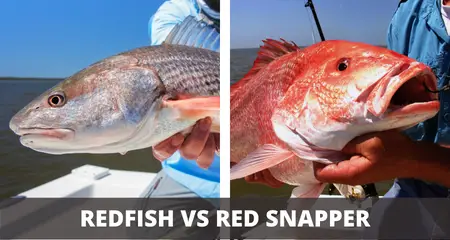
In this guide I’ll show you through the main differences between redfish vs red snapper, to help you tell them apart easily.
Are redfish and red snapper the same?
No, redfish and red snapper are distinct species that are not related to each other.
And while redfish and red snapper share several similarities (including their largely overlapping distribution range, a reddish body color, and the fact that their name starts with “red”), their overall appearance is quite different.
So, with a little practice it becomes easy to tell a redfish from a red snapper, and we’ll cover the most important characteristics that distinguish a red snapper from a redfish further down.
Redfish (Red Drum)
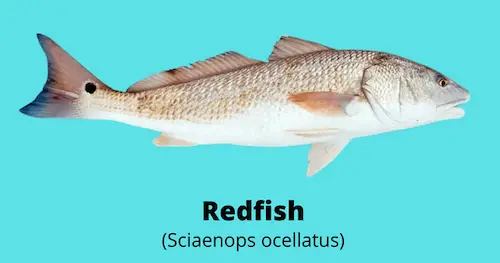
Scientific name: Sciaenops ocellatus
Also known as red drum, channel bass, or spottail bass, the redfish is found in coastal waters of the US Atlantic coast, as well as the Gulf of Mexico and the Caribbean ocean.
Redfish are very popular game fish, and are targeted by millions of anglers every year, fishing mostly from shore, and using a wide variety of redfish rigs and tactics.
Young redfish (also called puppy redfish) grow up in estuaries, shallow grass flats, and back country creeks. They grow very fast and reach sexual maturity at about 4 years of age.
When red drum reach a length of 27 inches they are called bull redfish, and at this stage most of them move out into deeper water to form large schools.
During the fall, bull redfish schools return from their deep water haunts back into shallow coastal waters in order to spawn, and this is called a bull redfish run.
Red Snapper (Northern Red Snapper)
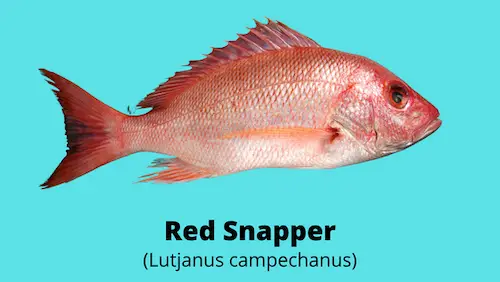
Scientific name: Lutjanus campechanus
The red snapper is also known as northern red snapper or pensacola red snapper. It is closely related to the southern red snapper, with which it shares some parts of its range in the Gulf of Mexico.
Red snappers are very popular game fish, and since they also make excellent table fare, they are highly sought after by both commercial trawlers and recreational anglers.
How to tell the difference between redfish and red snapper
Now let’s discuss the key differences that you should look for in order to tell a red snapper from a redfish.
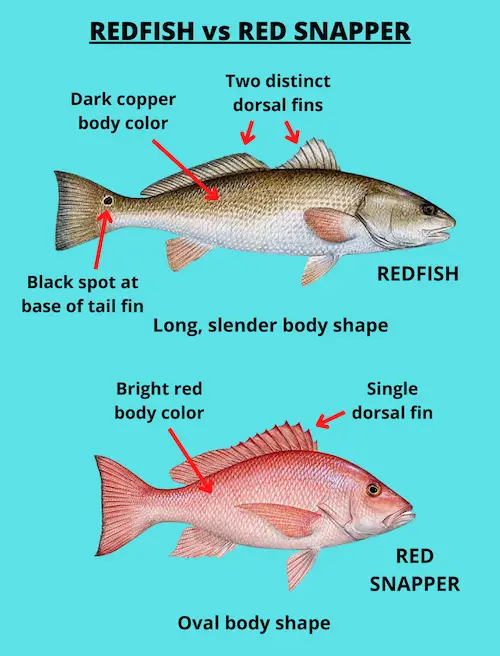
Body shape: While redfish have a slender, elongated body shape with a protruding head, red snapper are more oval shaped with an arched back and a short head.
Color: Red snapper have a bright red body color that resembles that of a goldfish. In contrast to this, redfish have a dark copper body color with a reddish hue, but this is nowhere near as red as the color of a red snapper.
Dorsal fin: While redfish have two distinct dorsal fins (the first of which has pointed spines), red snapper have a single, continuous dorsal fin (the front part of which has spines).
Mouth shape: While redfish have an underbite (their upper lip protrudes further than the lower lip), red snapper have an overbite (their lower lip protrudes further than the upper lip).
Size: Redfish are generally bigger than red snapper. While redfish can grow to enormous sizes of 50 pounds or more, red snapper rarely get bigger than 20 pounds.
However, there is considerable overlap in size among smaller redfish and red snappers, which means you can’t use size to distinguish the smaller ones.
Habitat: Adult red snapper prefer hard bottom, and are usually found close to reefs, wrecks, and other structures. Redfish, on the other hand, prefer muddy or sandy bottom, and are generally found closer to shore.
Water depth: While red snappers are found in water as deep as 600 feet in the Gulf of Mexico, redfish prefer more shallow waters that rarely exceed 60 feet. However, keep in mind that juvenile red snappers can also be found in shallow inshore waters.
Where can you find redfish?
Redfish are found in shallow coastal areas of the Atlantic Ocean, the Caribbean, as well as the Gulf of Mexico.
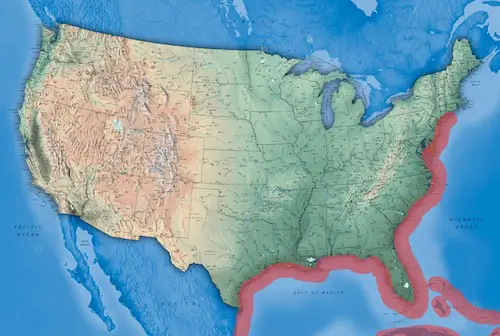
The range of redfish extends from northern Mexico in the south to Massachusetts in the north. They are often found in river mouths, seagrass flats, creeks, shell beds, and shallow bays.
Redfish can be found on many different types of bottom, but they prefer muddy bottoms as well as areas with underwater vegetation.
See also: What kind of fish do redfish eat?
Where can you find red snapper?
Red snapper are found along the coastal areas of the Gulf of Mexico, the Caribbean, as well as the Atlantic Ocean.
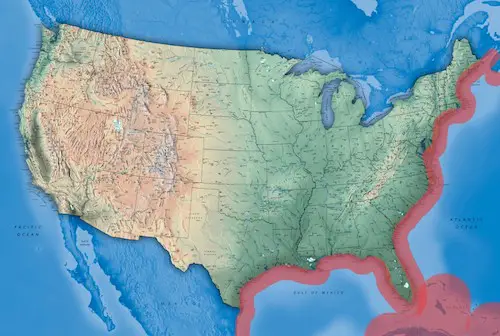
While the range of red snappers broadly overlaps with that of redfish, red snappers are usually found in deeper water than redfish, and their habitat thus extends farther out from the coast line.
Red snappers in general prefer hard bottom, and relate to reefs, ledges, wrecks, drop offs, and other underwater structures.
Types of red snapper
In addition to the northern red snapper, there are four other species of snappers that have red body color. These are the vermillion snapper, silk snapper, queen snapper, and the blackfin snapper.
And while these snapper species can be hard to distinguish from northern red snappers, they are relatively easy to tell from redfish, by looking for the same characteristics outlined above.
Red snapper vs redfish taste (which one tastes better?)
Redfish and snapper have a very similar taste, and both make excellent table fare. Both fish have white meat that has a flaky texture and a mild flavor that most people find delicious. Both are moist and have a relatively low fat content.
I’ve tried both redfish and snapper, and while I greatly enjoyed eating both of them, I found the red snapper a little more tasty with subtle nutty notes.
The fact that both of these fish are very good to eat led to a dramatic decline in their populations during the 1980s due to overfishing.
However, strict redfish bag limits and length limits were introduced during the late 80s, followed by equally strict red snapper limits. Due to these measures, both red drum and red snapper populations have largely recovered since then.
Finally, keep in mind that you should only eat small redfish under 27 inches, since the large ones become tough and chewy. In contrast, even big red snappers taste delicious.
